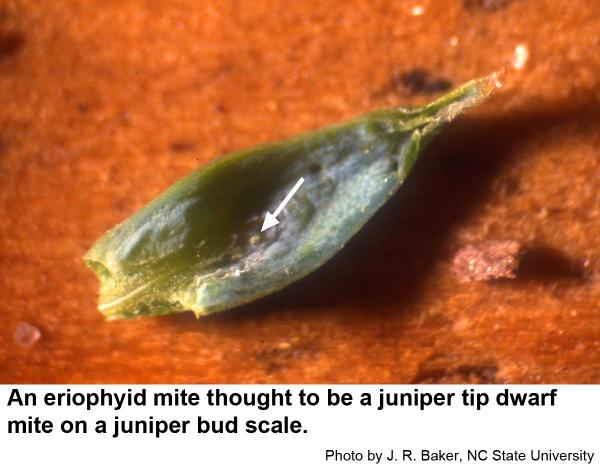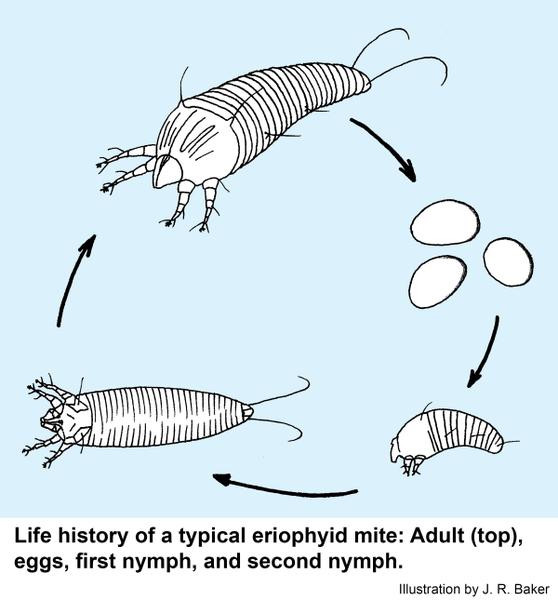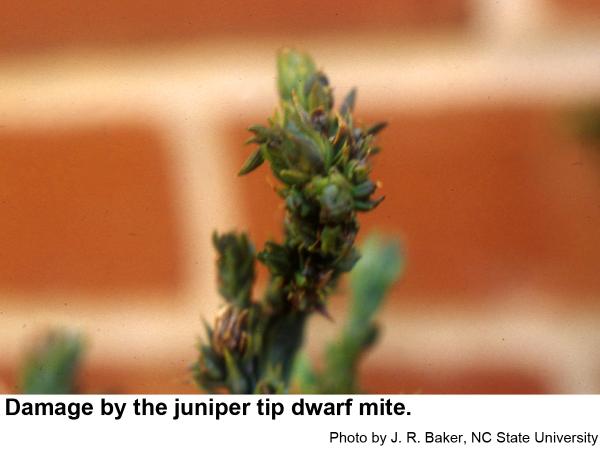Description and Biology
Juniper tip dwarf mites, Trisetacus juniperinus, are in the family of eriophyid mites. They have two pairs of legs at the front of the elongate, spindle-shaped body. The body is circled by numerous rings. These mites are virtually microscopic, but can be seen with a 10X hand lens. They have three setae on the prodorsal shield (hence the name Trisetacus). The scissor-like mouth parts are located in a groove on top of a frontal protrusion. Juniper tip dwarf mites feed by piercing the needles or buds of junipers and injecting their saliva. They then suck out the contents of the cells in the vicinity of the feeding wound. Females lay relatively large eggs from which hatch first nymphs. These incredibly small mites feed and molt into second nymphs that feed and eventually molt into adult mites. These mites can develop from eggs to adults in one week under favorable conditions. Hot weather often has a deleterious effect on eriophyid mites perhaps because it favors the development of a parasitic fungus, Hirsutella thompsonii.
Host Plants
Juniper is apparently the only host of the juniper tip dwarf mite. Some varieties are sensitive to eriophyid mite saliva and respond in several ways. A few junipers are apparently sensitive enough that the buds die after enough mites have fed in them. Other junipers develop funny-looking growth that resembles herbicide injury.
Residential Recommendations
Strangely enough, eriophyid mites are sensitive to the pesticide Sevin. Horticultural oils are also effective for mite control. Because juniper tip dwarf mites wedge under the scales of buds, they can be relatively difficult to eradicate so a second application two weeks later is a good idea.
Other Resources
- An Illustrated Guide to Plant Abnormalities Caused by Eriophyid Mites in North America. Keifer, H. H., et al. 1982. USDA ARS Agr. Handbook No. 573. 178 pages.
- Control of Juniper Tip Dwarf Mite. Cowles, R. S. 2001. Arthropod Management Tests 26 (1). G47.
- Horticultural Oils for Ornamental Plants. Franks, S. et al. 2018. Entomology Insect Notes, NC State Extension Publications.
- Relationships between eriophyoid mites and their host plants, with a case review of Eriophyoidea fauna of China. Hong, X. et al. 2001. Systematic and Applied Acarology, 6 (1):119-136.
Review of species of Trisetacus (Acari: Eriophyoidea) from North America, with comments on all nominate taxa in the genus. Smith, I. M.1984. Canadian Entomologist 116 (9): 1157-1211.
For assistance with a specific problem, contact your local N.C. Cooperative Extension Center.
This Factsheet has not been peer reviewed.
Publication date: Jan. 28, 2019
Reviewed/Revised: Nov. 9, 2023
Recommendations for the use of agricultural chemicals are included in this publication as a convenience to the reader. The use of brand names and any mention or listing of commercial products or services in this publication does not imply endorsement by NC State University or N.C. A&T State University nor discrimination against similar products or services not mentioned. Individuals who use agricultural chemicals are responsible for ensuring that the intended use complies with current regulations and conforms to the product label. Be sure to obtain current information about usage regulations and examine a current product label before applying any chemical. For assistance, contact your local N.C. Cooperative Extension county center.
N.C. Cooperative Extension prohibits discrimination and harassment regardless of age, color, disability, family and marital status, gender identity, national origin, political beliefs, race, religion, sex (including pregnancy), sexual orientation and veteran status.




